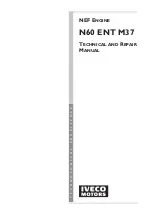
Always start the engine according to the procedure
that is described in the Operation and Maintenance
Manual, “Engine Starting” topic in the Operation
Section. Knowing the correct procedure will help to
prevent major damage to the engine components.
Knowing the procedure will also help to prevent
personal injury.
To ensure that the jacket water heater (if equipped)
and/or the lube oil heater (if equipped) is working
correctly, check the water temperature gauge and the
oil temperature gauge during the heater operation.
Engine exhaust contains products of combustion
which may be harmful to your health. Always
start and operate the engine in a well ventilated
area and, if in an enclosed area, vent the exhaust
to the outside.
Note:
The engine is equipped with an automatic
device for cold starting for normal conditions of
operation. If the engine will be operated in very cold
conditions, then an extra cold starting aid may be
required. Normally, the engine will be equipped with
the correct type of starting aid for your region of
operation.
The engines are equipped with a glow plug starting
aid in each individual cylinder that heats the intake air
to improve starting.
i01928905
Engine
Stopping
Stop
the
engine
according
to
the
procedure
in
the
Operation
and
Maintenance
Manual,
“Engine
Stopping
(Operation
Section)”
in
order
to
avoid
overheating
of
the
engine
and
accelerated
wear
of
the
engine
components.
Use
the
Emergency
Stop
Button
(if
equipped)
ONLY
in
an
emergency
situation.
Do
not
use
the
Emergency
Stop
Button
for
normal
engine
stopping.
After
an
emergency
stop,
DO
NOT
start
the
engine
until
the
problem
that
caused
the
emergency
stop
has
been
corrected.
Stop
the
engine
if
an
overspeed
condition
occurs
during
the
initial
start-up
of
a
new
engine
or
an
engine
that
has
been
overhauled.
This
may
be
accomplished
by
shutting
off
the
fuel
supply
to
the
engine
and/or
shutting
off
the
air
supply
to
the
engine.
i02176668
Electrical
System
Never
disconnect
any
charging
unit
circuit
or
battery
circuit
cable
from
the
battery
when
the
charging
unit
is
operating.
A
spark
can
cause
the
combustible
gases
that
are
produced
by
some
batteries
to
ignite.
To
help
prevent
sparks
from
igniting
combustible
gases
that
are
produced
by
some
batteries,
the
negative
“
−
”
jump
start
cable
should
be
connected
last
from
the
external
power
source
to
the
negative
“
−
”
terminal
of
the
starting
motor.
If
the
starting
motor
is
not
equipped
with
a
negative
“
−
”
terminal,
connect
the
jump
start
cable
to
the
engine
block.
Check
the
electrical
wires
daily
for
wires
that
are
loose
or
frayed.
Tighten
all
loose
electrical
wires
before
the
engine
is
started.
Repair
all
frayed
electrical
wires
before
the
engine
is
started.
See
the
Operation
and
Maintenance
Manual
for
specific
starting
instructions.
Grounding
Practices
Correct
grounding
for
the
engine
electrical
system
is
necessary
for
optimum
engine
performance
and
reliability.
Incorrect
grounding
will
result
in
uncontrolled
electrical
circuit
paths
and
in
unreliable
electrical
circuit
paths.
Uncontrolled
electrical
circuit
paths
can
result
in
damage
to
main
bearings,
to
crankshaft
bearing
journal
surfaces,
and
to
aluminum
components.
Engines
that
are
installed
without
engine-to-frame
ground
straps
can
be
damaged
by
electrical
discharge.
To
ensure
that
the
engine
and
the
engine
electrical
systems
function
correctly,
an
engine-to-frame
ground
strap
with
a
direct
path
to
the
battery
must
be
used.
This
path
may
be
provided
by
way
of
a
direct
engine
ground
to
the
frame.
All
grounds
should
be
tight
and
free
of
corrosion.
The
engine
alternator
must
be
grounded
to
the
negative
“
-
”
battery
terminal
with
a
wire
that
is
adequate
to
handle
the
full
charging
current
of
the
alternator.
M0105633-01
15
















































